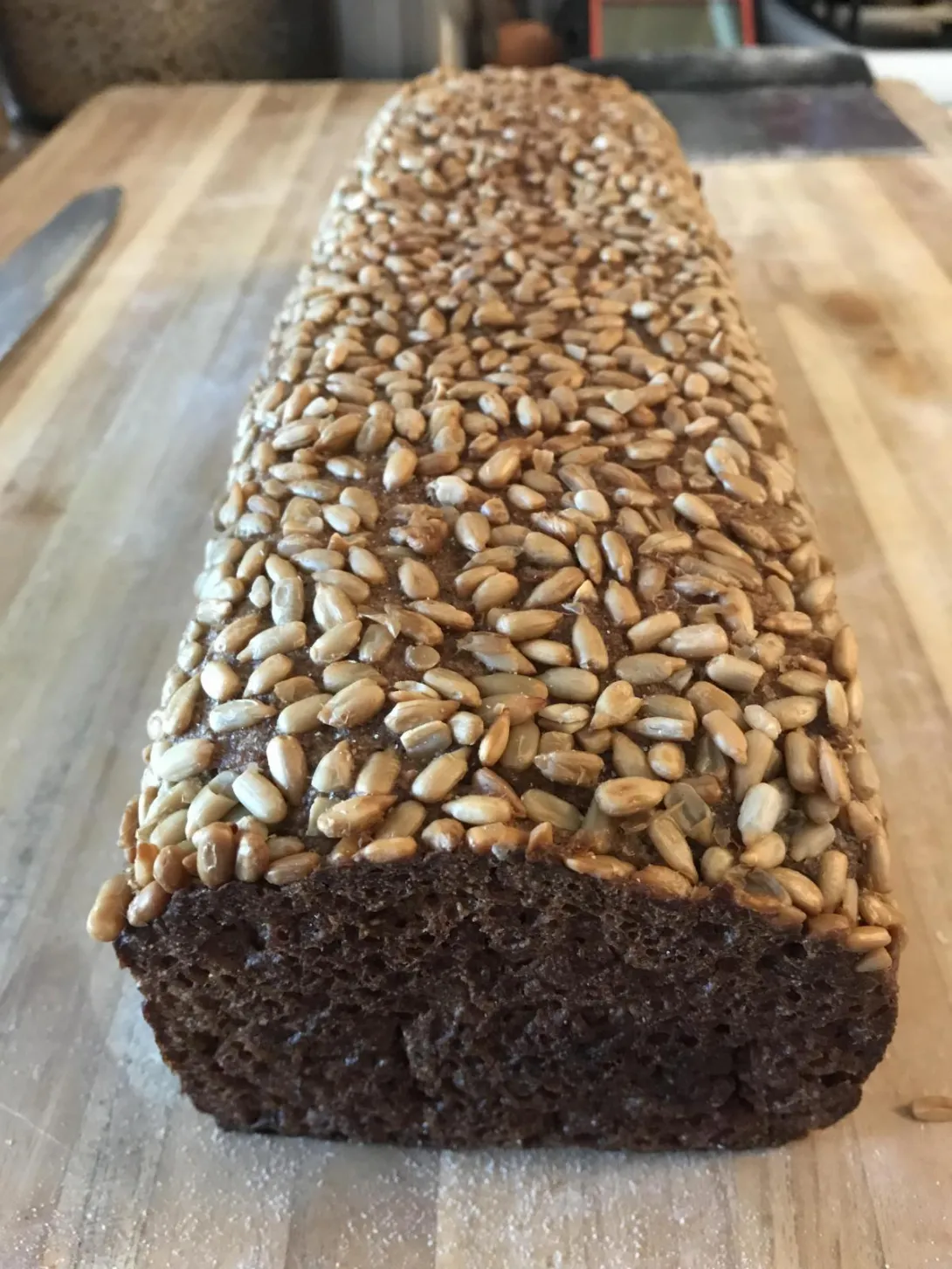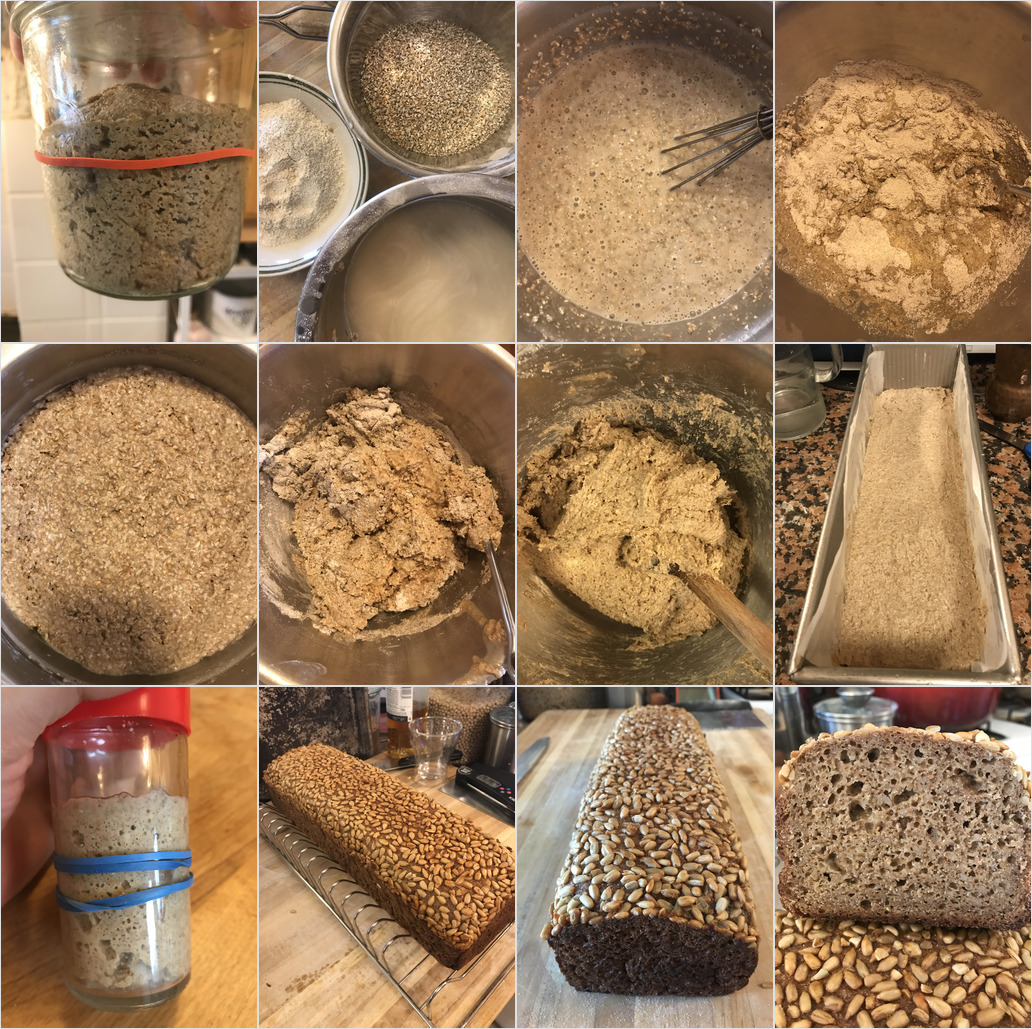
This is a beginner's attempt at Denise Polzelbauer's family Volkornbrot, from Daniel Leader's Living Bread. I ran my Mockmill 200 at a coarse setting and used a coarse kitchen sieve to catch the required rye chops. I used subsequent milling and flour sieves to create the coarse rye flour and (presumably finer) whole rye flour the recipe calls for. All of this was done by sifting guesswork. This was a slightly cumbersome process. Milling rye at a coarse setting on the Mockmill creates cracked rye in addition to a large percentage of finer rye flour. My understanding is coarse rye flour is beneficial in lieu of gluten for loaf shape and oven spring with 100% rye bakes. Perhaps there is a single coarse setting that can produce a usable blend of rye chops and coarse flour. The bake uses a two-stage 32-hour rye sour build: an 8-hour Grundsauerteig and a 24-hour Schaumsauerteig. The recipe called for 2 9x5 baking tins. Somehow I don't have any, so I used a large Pullman pan I recently purchased to make sandwich loaves. This seemed to work out fine. It calls for a desired internal temperature of 190 F, achieved after 1 1/2 hours at 375 F. I checked it at 1 1/2 hours and measured 208 F. Despite this discrepancy, it seems the loaf could still be baked longer. Perhaps baking as a single mega loaf alters the equation slightly and is more tolerant of a hotter and longer bake.

testing
- headupinclouds's Blog
- Log in or register to post comments
That’s a beaut, I love the sunflower seeded top crust. I bet it tastes great.
Benny
What a lovely rye loaf! I haven't tackled rye yet and all of these posts are making it difficult to decide which direction to go.
This was a second attempt using the same 3 stage formula from Living Bread. I made a few changes from the first attempt:
I think the added aeration from the slightly longer proof in the last one was beneficial, and would probably try to aim for 40% in the next one.
I don't have much of a point of reference for a well-made volkornbrot, and am interested in any pointers TFL rye bakers might have. I enjoy the flavor and would like to bake it regularly to complement my desem bakes. I'm baking this as a home-milled whole grain loaf. I'm not sure if it is typically made as a whole grain loaf or not. The recipe calls for rye chops, coarse rye, and whole rye flour. I'm guessing coarse rye is a whole rye flour in this context but could be wrong. I try to achieve this by weighing out rye berries for the total amount of flour in the recipe, followed by a few rounds of milling and sifting "by eye" to achieve various levels of coarseness. I use a standard wide mesh kitchen sieve for the rye chops and used the #30 and #40 sieve contents for the coarse rye flour, with everything passing through #50 making up the whole rye flour portion.
I opted for the volkornbrot mit sonnenblumen loaf, and included 260 g of pre-soaked sesame seeds in the dough and on the top crust. Previously I used these only on the top. I guesstimated the inner vs top portions incorrectly and ended up placing too many on the top. Some of these fell off and I didn't end up with quite the same uniformly toasted look as in the first one.
Any recommendations are welcome.
They add the salt to the second stage. I assume this is done to slow down fermentation to fit the production schedule. That would probably be: mix 1. stage in the morning, 2. stage at the end of the day, final dough the next morning.
You could achieve the same result at home in just two stages: mix the leaven overnight and the final dough in the morning.
I think I'm going to try this next week to see how the longer fermentation time affects the taste.
Your bread looks totally great.
If you do bake this one, please post it. It is the only volkornbrot I've tried, so I didn't realize adding salt in the second stage schaumsauerteig was unusual. The fermentation times were spot on. I have been happy with the results from simply following the process, but between milling and the multiple stage builds, it is somewhat of a commitment. Thankfully it keeps well and pays off for the following week.
I maintain my rye starter at 100% hydration and refresh at the ratio of 1:10:10. For the loaf on the right, I prefermented 50% of the flour at that inoculation. The one on the left was fermented following the Vollkornbrot recipe. (It seems to me the name is misspelled in the book, by the way.)
The 2-stage loaf proofed for 2.5 h and the 3-stage one 3.5 h, even though the amount of pre-fermented flour was higher.
I had to bake one after the other and the oven was hotter for 3-stage loaf.
The 2-stage loaf ended up being underproofed. Didn't burst in the oven, but it's denser than the other one.
The taste is very mild. Neither is sour at all, and I don't think I could tell them apart in a blind test.
I don't think the 3-stage process is worth the trouble in a home setting.
The crumb has a nice texture. Kudos on actually testing your theory with a side-by-side bake. That does make it more approachable. It seems multi-stage builds are quite common with rye (Detmolder, etc). Do you have experience with multi-stage rye builds where your feel you can tell a very clear difference in a blind taste test?
Did you gauge proof by the crack patterns on top of dough? I've read about that and it seems quite clear in your photos. Perhaps I would skip the seeds next time for this additional visual feedback. I think it recommends a 20-30% final proof in the book. The first one I did probably reached about 50% and it seemed well aerated but a touch over-proofed. I aimed for 25% per the recipe in the second one and I think it was probably under-proofed. Perhaps I'll split the difference in the next one.
It calls for whole rye flour and coarse rye flour. I was guessing coarse rye flour implied whole coarse rye flour. I tried to approximate this with my mill but found no guidelines and ended up guessing. Did you use separate coarse and whole rye flours?
Note: For some reason most of the details in my initial post disappeared. If I click edit I can still see the write-up and photos, but when I preview, view or even re-save and view most of the details are omitted.
It sounds interesting, but it seems one would have to reserve a whole weekend just to bake bread. I usually adjust the sourness with hydration and the amount of pre-fermented flour. Hamelman's Vollkornbrot has 41% of flour pre-fermented. I tried going up to 60%, which was too sour. I used to maintain the started at 120% hydration. It smells more pleasant (fruitier), but the yeasts seem to suffer. Now I maintain it at 100% (and it smells sharp and vinegary), but pre-ferment the levain (50% of the flour) at 120%.
You gauge proof by cracks and height. When you've made the same recipe several times, you learn how much the dough is supposed to rise. Cracks are very helpful, but stiffer doughs make deeper cracks more suddenly and looser doughs can rise more without cracking. This recipe is 85% hydration, I usually use 88%.
I think the whole rye and coarse rye mean the same thing in the recipe. I just use what I can get at the store. The flour is not particularly fine:
As noted above. For some reason the full version of the initial post isn't displaying, but the full post is there in edit mode. I am re-posting the html here for reference.
This is a beginner's attempt at Denise Polzelbauer's family Volkornbrot, from Daniel Leader's Living Bread. I ran my Mockmill 200 at a coarse setting and used a coarse kitchen sieve to catch the required rye chops. I used subsequent milling and flour sieves to create the coarse rye flour and (presumably finer) whole rye flour the recipe calls for. All of this was done by sifting guesswork. This was a slightly cumbersome process. Milling rye at a coarse setting on the Mockmill creates cracked rye in addition to a large percentage of finer rye flour. My understanding is coarse rye flour is beneficial in lieu of gluten for loaf shape and oven spring with 100% rye bakes. Perhaps there is a single coarse setting that can produce a usable blend of rye chops and coarse flour. The bake uses a two-stage 32-hour rye sour build: an 8-hour Grundsauerteig and a 24-hour Schaumsauerteig. The recipe called for 2 9x5 baking tins. Somehow I don't have any, so I used a large Pullman pan I recently purchased to make sandwich loaves. This seemed to work out fine. It calls for a desired internal temperature of 190 F, achieved after 1 1/2 hours at 375 F. I checked it at 1 1/2 hours and measured 208 F. Despite this discrepancy, it seems the loaf could still be baked longer. Perhaps baking as a single mega loaf alters the equation slightly and is more tolerant of a hotter and longer bake.
testing